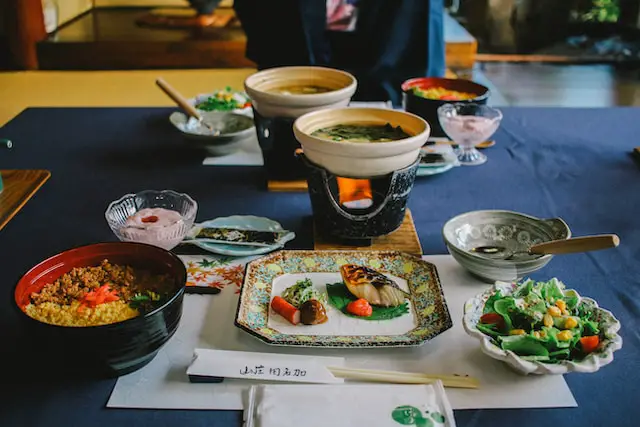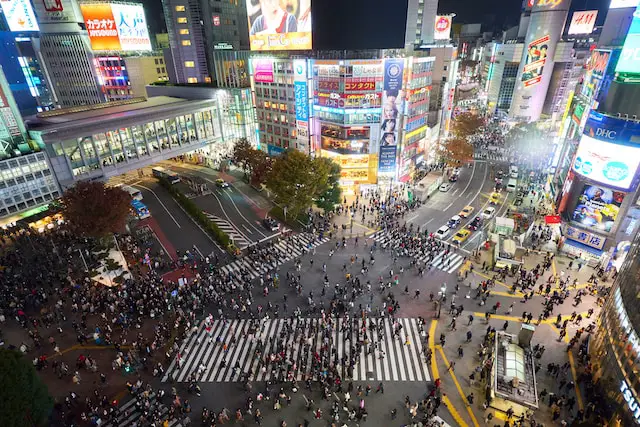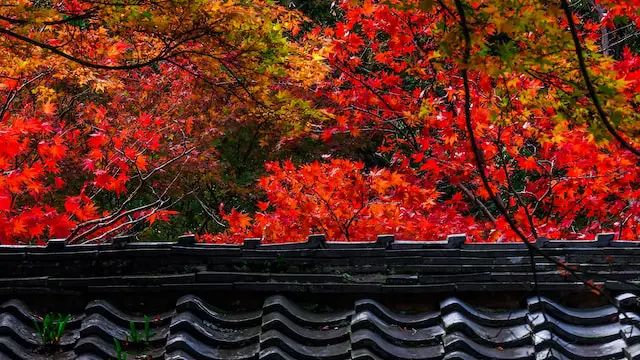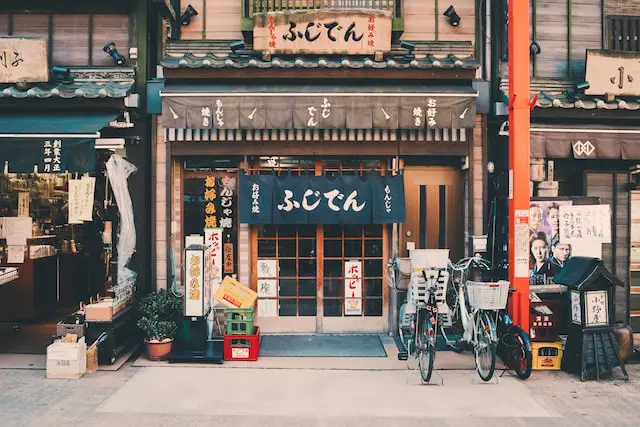Delve into the culinary treasures of Japan, a country celebrated worldwide for its gastronomic delights. Japanese food culture is a mélange of tradition and trend, where meticulous preparation meets diverse flavors. From the bustling lanes serving smoky street delicacies to the quiet elegance of Michelin-star restaurants in Japan, this food landscape boasts an unparalleled variety.
Our aim for this journey is to guide you through the best of the Japanese gourmet world. With a primary focus on both ends of the spectrum, this gastronomic journey will explore local street food gems and the precision cuisine offered by Michelin-starred restaurants. So, fasten your seatbelts and prepare your palates as we embark on an enthralling journey, tasting our way from the streets to the skies of Japan, thereby truly encapsulating the diversity of Japanese gastronomy.
Michelin Star Dining in Japan
The coveted Michelin Star is a hallmark of fine dining quality, and restaurants worldwide aspire to earn this prestigious accolade. It is considered one of the highest honors in the culinary world. For a gourmet, dining at a Michelin-starred restaurant is an experience to savor and remember.
Japan is densely packed with dining establishments that bear these esteemed stars. In fact, with a staggering number of Michelin-starred restaurants to its name, the Michelin Star in Japan holds an exceptional concentration. This is a testament to the country’s extraordinary culinary scene, influencing international gastronomy with its intricacy, precision, and distinct flavors.
With Tokyo leading the way as the city with the most Michelin stars worldwide, Japan boasts a formidable presence in haute cuisine. The country’s passion for food and obsession with quality ingredients is reflected considerably in these high-end establishments, thus affirming the status of Japan as a supreme ‘foodie’ destination.
The ingenuity of Japanese chefs is celebrated in these star-studded restaurants that render unforgettable dining experiences. Their relentless pursuit of perfection, teamed with a profound respect for fresh ingredients, results in an array of refined dishes that resonate with the heart and soul of Japanese cuisine.
Indeed, the Michelin Star’s prevalence in Japan reflects the intricate balance and harmony that embodies Japanese food culture, promising a gastronomic indulgence unlike any other.
Famed Michelin-Starred Restaurants
Japan is a gastronomic paradise that boasts an impressive number of Michelin stars in Japan. An exploration of Japanese culinary excellence would be incomplete without a mention of the top-notch restaurants this country hosts. From sushi havens to cafes specializing in the art of Kaiseki, Michelin-starred restaurants in Japan present an unparalleled variety.
Tokyo is globally recognized as a gourmet capital, hosting the highest concentration of Michelin Star restaurants worldwide. Among them, famous Michelin 3-star restaurants in Tokyo like Sukiyabashi Jiro and Ryugin present an exquisitely crafted experience, embodying the finest of Japan’s sushi and contemporary Japanese cuisine.
Further along, the cultural heart of Japan, Kyoto, is known for its traditional cuisine, which has been preserved over the ages. Michelin-starred restaurants in Kyoto, like Hyotei and Kikunoi, renowned for their seasonal Kaiseki meals, promise a deeply satisfying gastronomic journey capturing the essence of the ancient city.
Finally, Michelin-starred restaurants in Osaka, like Hajime and Taian, excel in creating a harmonious blend of unique tastes and aesthetics, equally pleasing to the eyes and palate. These popular restaurants uphold acceptable dining standards with innovative cooking techniques and dedication to the craft.
Exceptional Culinary Experiences
As you traverse the vibrant Japanese food scene, the culinary experiences awaiting you in Michelin-starred restaurants are truly unparalleled.
Each restaurant, with its unique charm, brings to the table myriad flavors, techniques, and traditions steeped in history.
The epitome of precision and harmony, a traditional Kaiseki meal is one of the many highlights. This multi-course dining experience is ritually structured, reflecting the seasons with artistically presented, exquisitely fresh dishes. Every detail, from the ceremonial presentation to the gastronomic creations, is a testament to the Zen principle of mindfulness.
Stepping into a Michelin-starred Edomae sushi restaurant, you can expect an intimate encounter with Japan’s iconic dish. Expertly prepared by seasoned chefs, the sushi showcases meticulously sourced local seafood, each piece a harmonious blend of subtly seasoned rice and prime cuts of raw fish – a timeless classic in its finest form.
In contrast to the delicate zen-like Kaiseki and Edomae sushi experiences, the theatrics of Teppanyaki offer a different yet equally enchanting dining adventure. Witness chefs expertly flip, grill, and sizzle high-quality ingredients on a sizzling hot iron grill right before you.
These experiences epitomize the discipline, culinary expertise, and deep respect for ingredients at the heart of Japanese cuisine. With every bite, you are immersing yourself in a world of authentic flavors that evoke a profound appreciation for the meticulous Michelin-starred gastronomy of Japan.
Japanese Street Food Culture
Having indulged in the splendor of Michelin-star dining, let’s now traverse to the other end of Japan’s culinary spectrum. The contrast is part of what makes the Japanese food culture so rich and impressive.
The vibrant street food in Japan is an integral part of the country’s food narrative. Quick bites can be enjoyed at every corner, from bustling markets to quiet suburban streets. These simple yet irresistible offerings reflect the culinary creativity and passion of the Japanese people.
Visitors to Japan should not miss the renowned Japanese markets, epitomes of liveliness, color, and hearty street food. Among the most famous is Tokyo’s Tsukiji Fish Market, teeming with various seafood dishes and sushi. More gems await at Osaka’s Dotonbori Street and Kyoto’s Nishiki Market. These locations proudly wear the badge of the Japanese street food markets, where you can fully experience Japan’s street food culture.
If urban nightlife fascinates you, it is time to savor the best street food in Tokyo. Yurakucho Gado-shita, under the rail tracks of Yurakucho Station, turns into a lively yokocho (alleyway) brimming with izakayas and street food stalls come dusk. For a different vibe, stroll through Omoide Yokocho or ‘Memory Lane, ‘ which offers an old-world charm with its well-preserved Showa-era aesthetic.
When discussing street food in Japan, the lively city of Osaka cannot be left behind. Known as the nation’s kitchen, the Osaka street food scene spans districts like Dotonbori, Shinsekai, and Temma, offering a broad range of delicious fare. With its vibrant collection of street food stalls, Osaka is sure to satisfy the palate of any food enthusiast.
Must-Try Street Foods
As one leaves the luxurious surroundings of the Michelin-starred restaurants, the equally compelling world of Japanese street foods awaits. Japan’s street food culture is as rich and diverse as its high-end counterpart, promising a range of feasts for the senses.
Takoyaki is an iconic Japanese street food that is a must-try in Japan. These round, bite-sized dumplings filled with minced octopus, tempura scraps, pickled ginger, and green onion are quintessential delicacies originating from Osaka’s bustling street food scene.
Grilled over charcoal, Yakitori, Japan’s answer to the kebab, is another must-try street food. The skewered chicken pieces, basted in a sweet-savory sauce, are a perfect snack to accompany a cold beer on a warm evening.
Ramen, a hearty and comforting bowl of noodle soup, is ubiquitous in Japan’s street food landscape. Each region boasts its unique version of this beloved dish, from Tonkotsu ramen of Fukuoka to Shoyu ramen of Tokyo.
For dessert lovers, Crepe Harajuku is a tempting treat. Named after the vibrant district in Tokyo, these thin pancakes filled with fresh fruits, cream, and a myriad of delicious fillings, served wrapped, are a popular sweet street food option.
The Japanese street food scene offers a remarkable culinary journey of variety, authenticity, and, above all, flavor that rivals the finesse of its high-end cuisine. It’s an adventure in itself that every foodie must explore.
Comparison of the Dining Experiences
Japan offers a culinary landscape as diverse as it is delicious. The country’s food culture ranges from the ornate machinations of Michelin Star dining to the sizzling skillets of street food exploration. Each offers a unique lens experience and savor the rich tapestry of Japanese cuisine.
On one end, you have the precision and artistry of Michelin-starred restaurants. These establishments offer an unparalleled high-end dining experience. Each course is meticulously crafted to capture the season’s essence, highlighting fresh, local ingredients. The traditional Kaiseki meals are a sensational journey through the Japanese seasons, reflecting the transient beauty of nature. The same dedication to the craft can be found in restaurants offering specialized Edomae sushi and Teppanyaki menus. Eating at these establishments isn’t just about tasting food—it’s about immersing yourself in a refined culinary experience.
On the other hand, the humble yet vibrant street food stalls serve as another testament to Japan’s culinary brilliance. The crowded Osaka street food stalls and the compelling corners of the bustling Japanese street food markets offer a completely different yet equally mesmerizing dining experience. Here, traditional treats like Takoyaki, Yakitori, and Ramen offer a taste of Japan in its most straightforward, honest form.
Be it the Michelin-star embellished bistros or the lively roadside food stalls, both the dining experiences reveal quintessential aspects of the Japanese food culture – a dedication to fresh ingredients, a keen attention to detail, and a love for a communal dining experience.
Conclusion
Having swept our readers from exquisite arrays of meticulously prepared dishes at Michelin Star dining establishments to the vibrant energy and deeply satisfying comfort of street food exploration, we’ve covered broad ground in our epicurean journey.
Delicately crafted and served with ceremonial grace, Michelin Star restaurants in Japan offer unparalleled culinary treasures. From savoring rapturous Kaiseki courses to being engrossed by the story that Edomae Sushi narrates and reveling in theatrical Teppanyaki presentations, these celebrated spaces are a testament to Japan’s high-standard, artful, and mindful approach to food.
The ubiquitous street food stalls chart an equally indulgent course in stark contrast yet parallel in enjoyment. With the alluring aroma of Yakitori, warmth nesting in a bowl of Ramen, the playful orbs of Takoyaki, and the sweet delight of Crepe Harajuku, we delved into the heart of Japan’s street food culture, weaving an edible tapestry of flavors.
No journey to Japan can be considered complete without exploring these two culinary worlds, each enriching and lending depth to Japanese food culture. The daring flavors and complex techniques found in Michelin-star establishments enrich your senses. At the same time, the simplicity and heartiness of street food invoke comfort and connection to Japan’s vibrant daily life.
From counter dining at hushed sushi temples to lively street food stalls, the variety of culinary experiences in Japan is endless. So, let your taste buds be your guide to discovering this gastronomic utopia, whether it’s the elegance of a Michelin-starred establishment or the authenticity of a ramen stall crowded with locals. Remember, in Japan, food is more than mere sustenance—a lifestyle, a philosophy, and a celebration of tradition.




